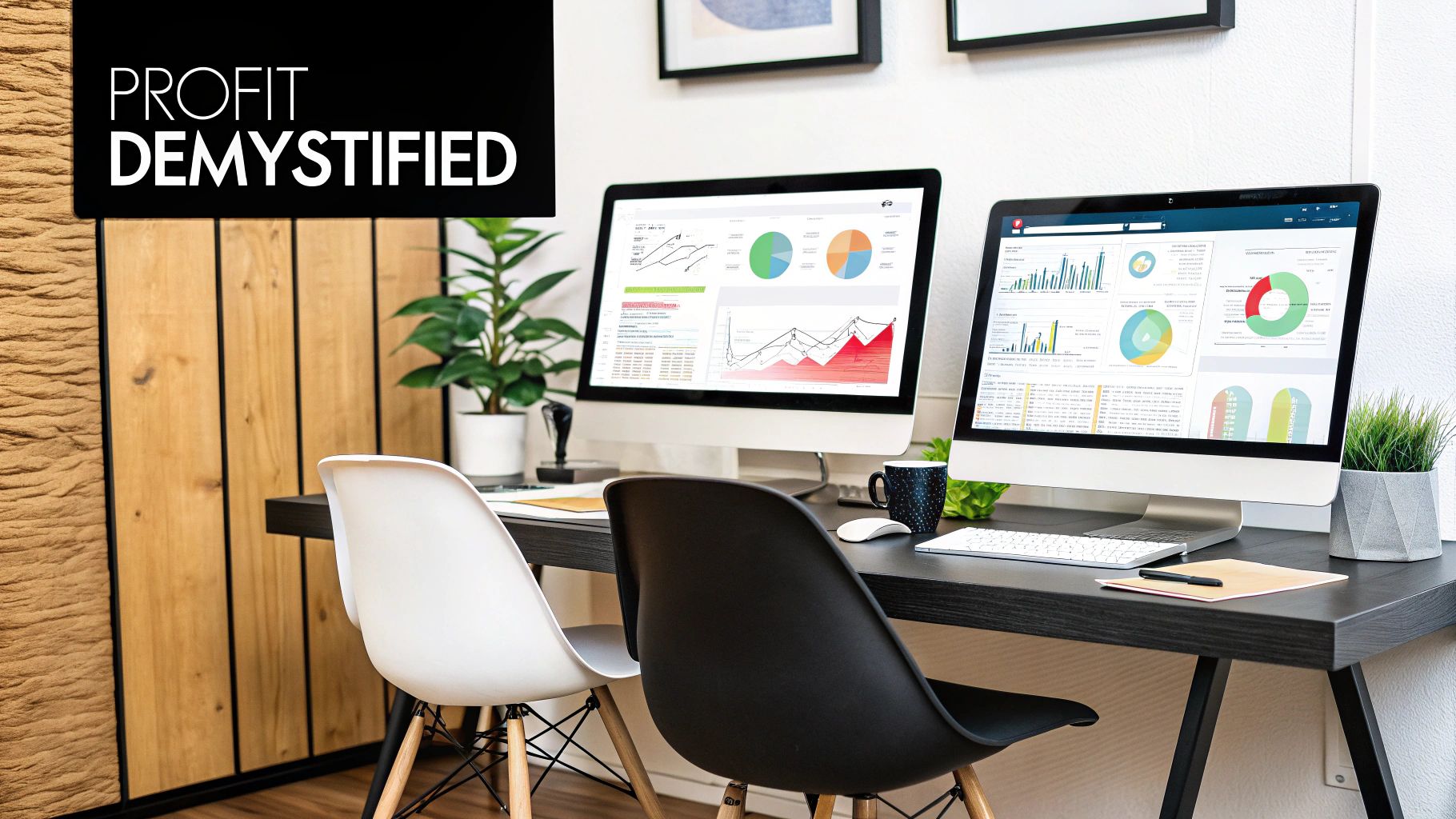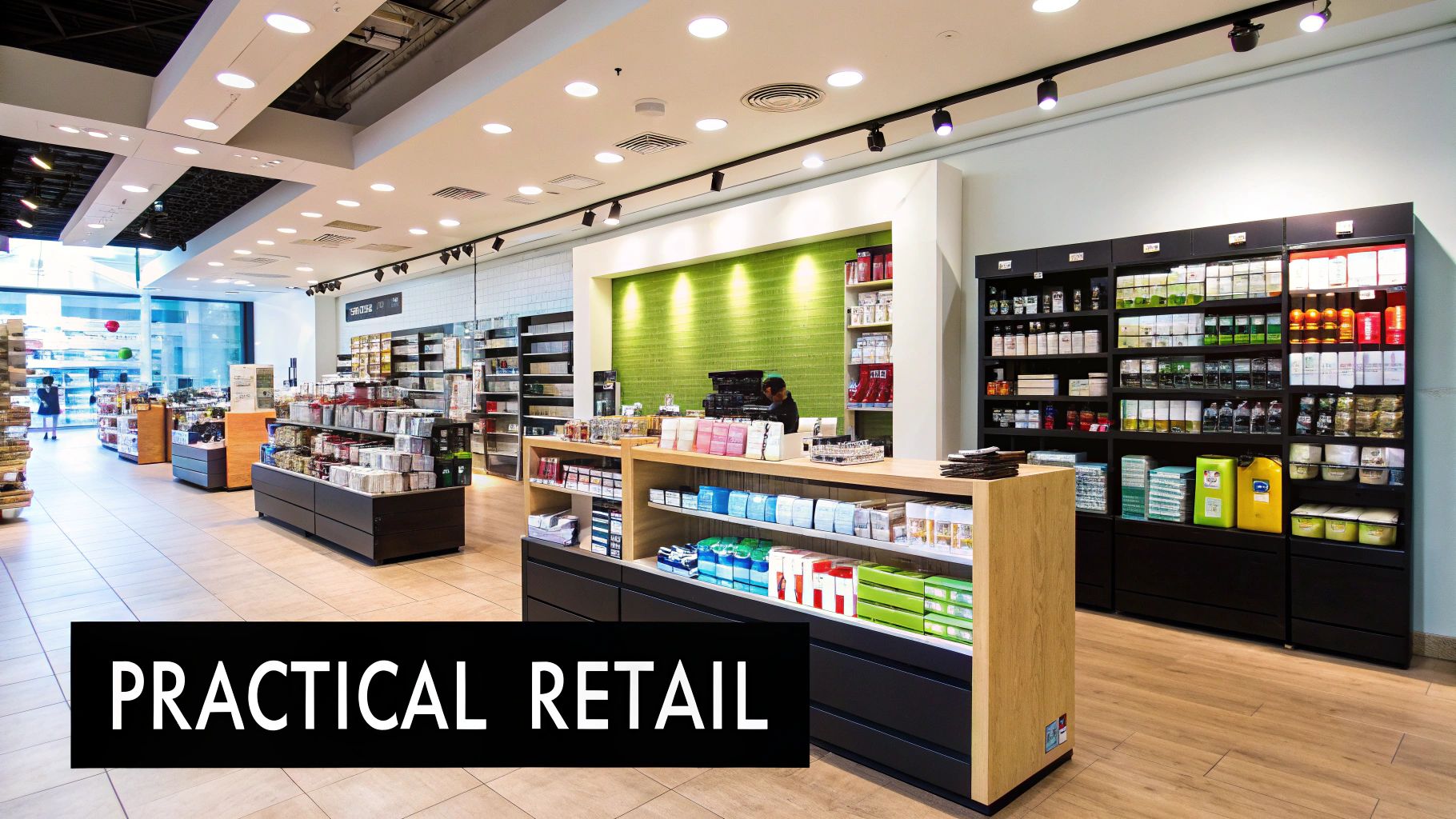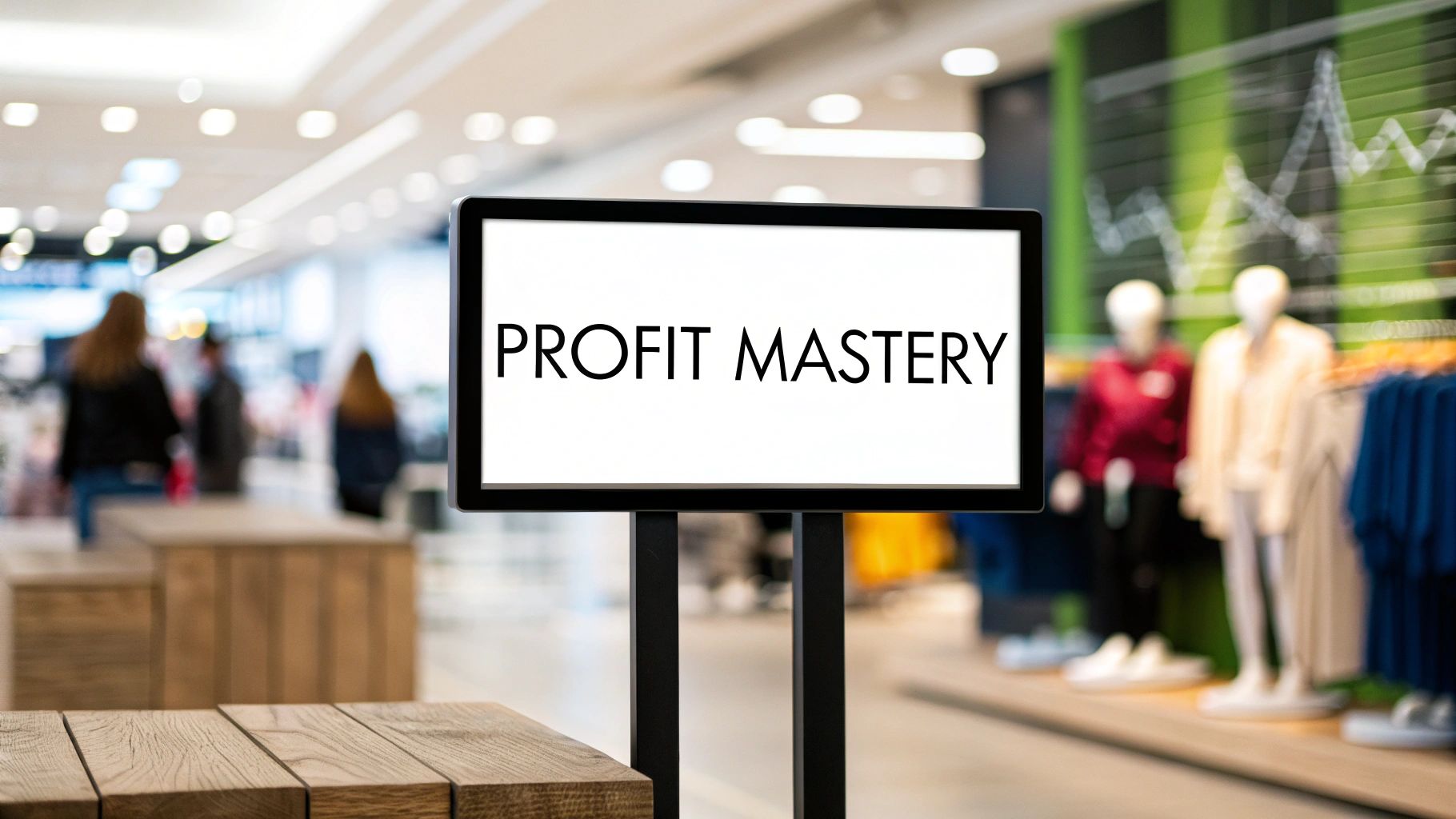The Art and Science of Retail Profit Margins

Understanding retail profit margins is essential for business success. They act as a guide for pricing strategies, inventory management, and overall business planning. This goes beyond simply knowing your revenue. It involves understanding the crucial relationship between costs, pricing, and ultimately, profit. Let's explore three key profit measures: gross profit margin, operating profit margin, and net profit margin.
Gross Profit Margin: The Foundation of Profitability
Gross profit margin represents the profit earned after deducting the direct costs of producing goods, known as the cost of goods sold (COGS). This is the foundation upon which other profit margins are built. A healthy gross profit margin provides a buffer to absorb operating expenses and other costs.
For example, if a product sells for $50 and the COGS is $20, the gross profit is $30. This results in a gross profit margin of 60%. This initial profit margin is key to ensuring the product's profitability from the outset.
Operating Profit Margin: Evaluating Core Business Operations
Building upon the gross profit, the operating profit margin factors in operating expenses. These expenses include costs such as salaries, rent, marketing, and administrative overheads. This metric shows how efficiently core business operations are being managed.
A higher operating profit margin indicates effective cost control alongside revenue generation. This efficiency can be achieved through various strategies. These include strategic cost management, streamlined operations, and effective pricing strategies.
Net Profit Margin: The Ultimate Profitability Indicator
Finally, the net profit margin is the ultimate measure of a business's profitability. This metric considers all expenses, including interest and taxes, to reveal the actual profit after all deductions. It shows the percentage of revenue that translates into pure profit.
For example, a business with $100,000 in revenue and a net profit of $15,000 has a net profit margin of 15%. This final profit figure is what truly matters for the business's bottom line.
The retail sector's profitability, as measured by these margins, can vary considerably. For instance, in the first quarter of 2025, the retail sector's gross margin fell to 12.52% due to rising costs, even with increased revenue. Historically, retail gross margins have reached as high as 47.81% in some quarters. More detailed statistics can be found here: https://csimarket.com/Industry/industry_Profitability_Ratios.php?s=1300. Understanding these fluctuations and their causes is crucial for effective margin management. Tracking these metrics allows businesses to identify trends and make informed decisions to optimize their profitability. Using a retail profit margin calculator can be a valuable tool in this process.
Mastering Your Retail Profit Margin Calculator

A retail profit margin calculator is more than just a tool for crunching numbers. It's essential for turning raw data into actionable business insights. Using this tool effectively means understanding the inputs, correctly interpreting the outputs, and then applying these results to your overall retail strategy. This guide will walk you through the practical application of a retail profit margin calculator, empowering you to make confident, data-driven decisions.
Understanding the Inputs: Garbage In, Garbage Out
Accurate calculations depend on accurate inputs. Think of your retail profit margin calculator as a recipe: the quality of the ingredients determines the quality of the dish. Even minor data entry errors can lead to significant miscalculations and ultimately, poor business decisions.
Understanding the key inputs is critical. These include revenue, cost of goods sold (COGS), and operating expenses.
-
Revenue: This is your total income from sales. It's crucial to use accurate sales data, factoring in returns and discounts.
-
Cost of Goods Sold (COGS): This represents all direct costs associated with producing or acquiring your products. Accurately tracking COGS is vital. It should encompass materials, labor, and freight costs.
-
Operating Expenses: These expenses are tied to the daily running of your business. They include rent, salaries, and marketing. Carefully categorizing and tracking these allows for a more realistic profit margin calculation.
To further clarify the required inputs, the following table details each data point necessary for accurate margin calculations.
Essential Inputs for Your Margin Calculator
A comprehensive breakdown of all data points needed for accurate margin calculations
| Data Point | Definition | Where to Find It | Common Pitfalls |
|---|---|---|---|
| Revenue | Total income from sales | Sales reports, POS systems | Excluding returns and discounts |
| Cost of Goods Sold (COGS) | Direct costs of producing or acquiring products | Inventory management system, invoices | Overlooking freight or manufacturing overhead |
| Operating Expenses | Costs of running the business (rent, salaries, marketing, etc.) | Accounting software, expense reports | Miscategorizing expenses |
| Selling Price | The price at which you sell your product | Product listing, price tags | Forgetting to factor in sales tax |
| Discounts/Returns | Reductions in price or returned products | Sales data, return records | Inconsistent tracking practices |
This table outlines the critical data you'll need to gather for a comprehensive and accurate profit margin calculation. Ensuring accurate data collection for these fields is the first step towards gaining valuable insights into your business's financial health.
From Calculation to Action: Applying Margin Insights
The true value of a retail profit margin calculator lies in how you apply the resulting insights. Successful retailers don't just note the final number; they analyze it, comparing it to industry benchmarks and previous performance. This analysis can reveal hidden profit opportunities and areas for improvement.
A lower-than-expected profit margin could signal issues with pricing, COGS, or operating expenses. Using the calculator can help isolate the source of the problem. Is your pricing too low? Are COGS too high? Are operating expenses out of control? This targeted approach empowers you to take specific actions, eliminating guesswork.
Comparing margins across different product categories can highlight your most profitable products. This information can be used to optimize your product mix, focusing on high-margin items that contribute significantly to your bottom line. These insights are also crucial for inventory management and strategic purchasing decisions, maximizing your return on investment. Mastering the application of your retail profit margin calculator gives you the tools to make strategic decisions that drive sustainable business growth.
Beyond Averages: Retail Margin Benchmarks That Matter

Calculating your retail profit margin is a good start, but it's not the whole story. To truly gauge your business's financial health, you need to compare your margins with industry benchmarks. This helps you identify areas for improvement and see how you measure up against competitors.
This knowledge allows you to use your retail profit margin calculator more strategically, benchmark performance, and set realistic, ambitious goals.
Understanding Industry Averages: A Starting Point
Industry averages provide a valuable starting point. They give a general overview of typical profitability in your sector. However, these averages are not universal. A small boutique will have different margin expectations than a national chain.
Profitability also varies significantly between retail sub-sectors. Grocery stores typically have lower margins than general retailers. In the US, the average gross margin for grocery stores is around 26.09%, while general retailers average about 32.22%.
Similar trends exist in the UK, with discount supermarkets like Aldi and Lidl gaining market share due to their cost-effective models, especially attractive during economic downturns. For further research on industry margins, see Professor Damodaran's data: Industry Margins. While industry averages offer context, a more granular approach is essential for effective benchmarking.
Benchmarking Beyond the Basics: Factors That Influence Margins
Many factors influence profit margins. A deep dive into your specific niche is essential. Key factors include your retail category, business size, and business maturity.
Luxury retailers, for example, often have higher margins than discount retailers. Established businesses with economies of scale typically outperform startups in margin performance. This understanding is vital for setting realistic goals.
Here are key benchmarks to consider:
-
Retail Category: Compare your margins to direct competitors in your category (e.g., apparel, electronics, grocery) for a more relevant comparison than broad retail averages.
-
Business Size: Consider your revenue and market share relative to competitors. Larger retailers often benefit from economies of scale, impacting margins.
-
Business Maturity: Startups usually have lower margins while investing in growth. Mature businesses tend to have higher margins due to established processes and market presence.
Understanding these nuances gives you a more focused benchmark, letting you evaluate your performance against truly comparable peers.
To further illustrate these nuances, let's examine some benchmark data:
Retail Profit Margin Benchmarks by Sector
| Retail Sector | Average Gross Margin | Average Net Margin | Profit Leaders |
|---|---|---|---|
| Apparel & Accessories | 45-55% | 8-12% | Designer Brands, Luxury Retailers |
| Electronics | 25-35% | 3-7% | Apple, Best Buy |
| Grocery | 20-30% | 1-3% | Whole Foods Market, Trader Joe's |
| Home Improvement | 30-40% | 5-9% | Home Depot, Lowe's |
| Online Retail | 35-45% | 5-10% | Amazon, Wayfair |
This table provides a general overview. Actual margins can vary based on specific business models and market conditions. It highlights the generally higher gross and net margins in specialized sectors like Apparel and Accessories, compared to the highly competitive and low-margin Grocery sector. Profit leaders are often characterized by strong branding, efficient operations, and premium pricing strategies.
Actionable Insights: Turning Benchmarks Into Strategies
Understanding your benchmark position allows you to develop actionable strategies. Consider Mergoio, a sales and profit tracking software for TikTok Shop sellers. Mergoio provides real-time analytics, letting you monitor margins and compare them against benchmarks.
This data empowers you to make informed decisions, optimizing pricing and inventory management for maximum profitability. Benchmarking can also inform your overall business strategy.
Margins significantly below average might signal a need for pricing adjustments or cost reductions. Conversely, above-average margins validate your current strategies, allowing you to refine your approach and maintain a competitive edge. Comparing your margins to relevant benchmarks, especially with a tool like Mergoio, is crucial for maximizing profitability and achieving sustainable growth.
Proven Strategies to Elevate Your Retail Margins
Boosting your retail margins requires a strategic approach that blends smart pricing with efficient operations and a deep understanding of your customer. Let's delve into proven strategies that retailers are using to improve their bottom line while nurturing lasting customer relationships.
Pricing Psychology: The Art of Premium Positioning
Pricing isn't simply about numbers; it's about the perceived value. Using pricing psychology techniques can position your products as premium offerings without deterring price-conscious shoppers.
-
Charm Pricing: Ending prices with .99 (e.g., $9.99 instead of $10.00) creates a sense of value. This tactic utilizes the left-digit effect, where consumers tend to focus on the first digit of a price.
-
Prestige Pricing: Using round numbers (e.g., $100 instead of $99.99) can signal quality and exclusivity. This appeals to customers seeking high-end products.
-
Bundling: Offer product bundles at a slightly reduced price compared to buying items individually. This strategy increases the average order value and encourages customers to buy more.
For example, bundling shampoo and conditioner together can be more enticing than selling them separately, ultimately leading to higher sales and increased profits.
Inventory Optimization: Minimizing Costs, Maximizing Availability
Effective inventory management is essential for profitability. Excess inventory ties up capital and increases carrying costs, while stockouts result in lost sales and unhappy customers.
-
Demand Forecasting: Accurately predicting future demand helps avoid overstocking or running out of product. Use past sales data, market trends, and seasonal influences to inform your forecasts. Tools like Tableau can be helpful for visualizing this data.
-
Just-in-Time Inventory: Minimize inventory holding costs by receiving goods only when they are needed. This requires strong relationships with suppliers and efficient logistics.
-
Regular Stock Audits: Frequent stock audits identify discrepancies and help prevent inventory shrinkage due to theft, damage, or administrative errors.
Retail sales data often reveals valuable trends. For example, retail sales in the UK saw a 1.7% month-over-month increase in January 2025, largely due to a 5.6% rise in food store sales. This highlights the significance of the food retail sector in overall profitability. More detailed statistics can be found here: UK Retail Sales. This data can help retailers optimize inventory for specific product categories.
Cost Reduction Strategies: Efficiency Without Compromise
Reducing costs doesn't have to mean sacrificing quality or the customer experience. Strategic cost reduction focuses on finding areas for improvement without negatively affecting your brand's value.
-
Negotiate with Suppliers: Leverage your purchasing power to negotiate better prices and terms with your suppliers. Explore options for bulk discounts or longer payment terms.
-
Optimize Shipping Costs: Evaluate different shipping carriers and methods to find the most cost-effective options for your business. Consider packaging that minimizes both shipping weight and dimensions.
-
Energy Efficiency: Implement energy-saving measures in your retail space. This could include using energy-efficient lighting and optimizing your heating and cooling systems.
These strategies, combined with the effective use of a retail profit margin calculator, can significantly improve your bottom line.
Leveraging Your Retail Profit Margin Calculator
A retail profit margin calculator is a powerful tool, especially when used in conjunction with these strategies. By inputting accurate data and adjusting variables based on your pricing, inventory, and cost reduction strategies, you gain valuable insights.
-
Scenario Planning: Model different scenarios, such as price increases or cost reductions, to evaluate potential outcomes and make informed decisions.
-
Performance Tracking: Monitor your actual margins against your projections to identify areas where performance is exceeding or falling short of expectations.
-
Strategic Adjustments: Make strategic adjustments to your pricing, inventory, or cost reduction strategies based on real-time data and market trends. This iterative process ensures you're constantly optimizing your margins for maximum profitability.
By implementing these strategies and using your retail profit margin calculator, you can transform your approach to profitability, building a resilient and thriving retail business.
Building Your Retail Margin Tracking System

Successfully managing retail margins isn't a one-time task. It requires continuous tracking and analysis. This process transforms individual data points into actionable insights, enabling ongoing improvement and uncovering hidden profit potential. This section explores building a robust system to optimize your retail profitability.
Identifying Seasonal Patterns and Margin Fluctuations
A key advantage of a tracking system is its ability to identify trends and patterns. This includes recognizing seasonal highs and lows in your margins. For example, swimwear typically sees higher margins during summer, while winter coats peak in colder months. Tracking these fluctuations allows for proactive pricing and inventory adjustments, maximizing profitability year-round. Understanding these patterns also allows you to anticipate potential challenges and opportunities, building resilience against market shifts.
Visualizing Data for Team Accessibility
Data, no matter how complex, is only valuable if it's understandable. Visualizations, such as charts and graphs, transform raw numbers into accessible insights for your entire team. This shared understanding promotes collaboration and data-driven decisions across all departments. From sales to marketing, everyone can grasp the impact of their actions on profit margins. This transparency ensures alignment and a shared focus on profitability throughout your organization.
Forecasting Future Performance With Historical Data
Historical margin tracking isn't just about the past; it's a powerful tool for predicting the future. By analyzing past performance, you can forecast future margins with increased accuracy. This enables proactive planning and resource allocation, preparing you for upcoming challenges and seizing emerging opportunities. This predictive capability offers a competitive edge, allowing you to anticipate and adapt to market changes.
This is especially crucial in the UK, where fluctuating corporate profits influence the retail sector. In the fourth quarter of 2024, UK corporate profits dropped to £147,267 million, reflecting broader economic headwinds. Maintaining profitability in such conditions requires strategic pricing and cost management. The UK retail sector contributed £111.8 billion to the UK economy in 2024, representing 4.5% of total output. For more detailed statistics, visit: UK Corporate Profits. This highlights the critical role of accurate forecasting for sustained profitability.
Implementing Your Tracking System: Tools and Timelines
Building a margin tracking system requires appropriate tools and a realistic timeline. Consider your business size, technical capabilities, and available resources.
-
Spreadsheet Software: For smaller businesses, spreadsheet software like Microsoft Excel or Google Sheets can provide a basic but functional tracking system.
-
Dedicated Retail Software: As your business expands, dedicated retail management software, such as Mergoio (https://mergoio.com), provides advanced analytics and reporting, especially for e-commerce sellers on platforms like TikTok Shop.
-
Implementation Timelines: A phased approach is recommended. Begin by tracking key metrics, then gradually expand your system as your needs change. This ensures a smoother transition and minimizes disruption.
-
Resource Allocation: Dedicate resources for data entry, analysis, and system maintenance. Training your team on effective system usage maximizes its value.
Ready-to-Use Templates and Tool Recommendations
Jumpstart your system with ready-to-use templates and recommended tools.
-
Templates: Download free margin tracking templates online and customize them to your business needs. This saves time and ensures data collection consistency.
-
Tool Recommendations: Explore industry-leading retail management software, including Shopify, Lightspeed, and Mergoio, each offering different features to suit varying business needs.
Building a robust margin tracking system is a worthwhile investment. By consistently monitoring, analyzing, and acting on margin data, you gain crucial insights into your business's financial health. This empowers informed decisions, driving sustainable growth and strengthening your competitive position in the retail market.
Next-Level Margin Analysis For Retail Innovation
Moving beyond basic margin calculations is crucial for sustainable growth in the competitive retail sector. Advanced margin analysis reveals hidden opportunities across product categories, customer segments, and sales channels, empowering retailers to make data-driven decisions about product development, customer acquisition, and expansion strategies. This section bridges the gap between basic margin management and advanced analytics, offering practical steps for implementation regardless of your current analytical capabilities.
Unveiling Hidden Opportunities With Advanced Analysis
Innovative retailers don't just calculate margins; they dissect them. Analyzing margins across different product categories identifies the most profitable items. This informs strategic decisions like product mix optimization, prioritizing high-margin products, and discontinuing less profitable ones. This targeted approach maximizes return on investment and frees up resources for future growth.
Analyzing margins across different customer segments is also crucial. By understanding which customer groups generate the highest profits, retailers can tailor marketing campaigns and loyalty programs more effectively. High-value customers might receive exclusive discounts or early access to new products, strengthening loyalty and driving repeat purchases. This strategic segmentation optimizes marketing spend and boosts overall profitability.
Finally, analyzing margins across various sales channels—physical stores, online marketplaces, and direct-to-consumer websites—reveals the most profitable avenues. Retailers can then strategically allocate resources, optimizing their online presence, enhancing in-store experiences, or expanding into new markets.
Incorporating Overhead Allocation, Seasonal Adjustments, and Promotional Impact
A truly comprehensive margin analysis considers factors beyond cost of goods sold (COGS) and revenue. This includes accurately allocating overhead costs, accounting for seasonal fluctuations, and evaluating the true impact of promotions. Accurately distributing overhead expenses like rent, utilities, and administrative costs across product lines or departments provides a more granular view of profitability.
Seasonal adjustments are also essential. Accounting for predictable fluctuations in demand, such as higher margins for winter apparel during colder months, allows for proactive inventory management and pricing strategies. This ensures optimal stock levels and maximizes profitability during peak seasons.
Analyzing promotional effectiveness is equally important. While discounts boost sales volume, understanding the trade-off between increased revenue and reduced margin per unit is crucial. This analysis informs strategic pricing decisions, ensuring promotions drive profitability, not just short-term sales increases.
The retail sector’s profitability is gauged through various metrics, including gross, operating, and net margin. In Q1 2025, the retail sector's gross margin decreased to 12.52% due to rising costs despite a 2.53% revenue increase. Historically, retail gross margins have reached as high as 47.81%. Find more detailed statistics here: Retail Sector Profitability. This data underscores the importance of sophisticated margin analysis in navigating fluctuating market conditions.
Data-Driven Decisions For Retail Innovation
Data-driven retailers use sophisticated margin analysis to inform critical business decisions. This includes strategic product development, focusing on items with high-profit potential aligned with market demand. It also involves targeted customer acquisition, prioritizing customer segments with the highest contribution to the bottom line. Finally, it informs strategic market expansion, identifying new opportunities and tailoring strategies for maximum profitability. This data-centric approach empowers retailers to adapt to changing market conditions and remain competitive.
By moving beyond basic calculations and embracing advanced techniques, retailers unlock valuable insights that drive innovation and sustainable growth. This forward-thinking approach positions businesses for long-term success in the dynamic retail market.
Ready to transform your retail business with data-driven insights? Mergoio, sales and profit tracking software designed for TikTok Shop sellers, offers real-time analytics and a comprehensive dashboard. It empowers you to monitor performance, analyze product and SKU details, understand sales drivers, and leverage predictive models for accurate cost forecasting. Optimize your operations, boost profitability, and replace guesswork with data-driven decisions. Explore Mergoio today: https://mergoio.com

Leave a Reply